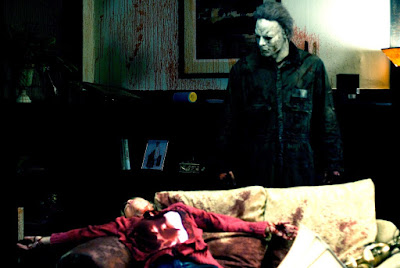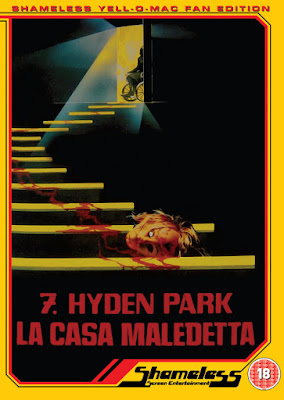 |
| From https://s-media-cache-ak0.pinimg.com/736x/13/ 99/c0/1399c0b2c120442f8f497c0bd9ec74e7.jpg |
Director: Rob Zombie
Screenplay: Rob Zombie (with
credit to John Carpenter and Debra Hill)
Cast: Malcolm McDowell (as Dr.
Samuel Loomis); Daeg Faerch/Tyler Mane (as Michael Myers, Age 10/Adult); Sheri
Moon Zombie (as Deborah Myers); Scout Taylor-Compton (as Laurie Strode); Danielle
Harris (as Annie Brackett); Brad Dourif (as Sheriff Lee Brackett)
A Night of a Thousand Horror (Movies) #76
 After Halloween: Resurrection (2002), a drastic change was required to
attempt to sustain the franchise but the result was incredibly divisive. It
didn't help that by this point, remakes were already looked down upon in spite
of the trend being with us, in terms of announcements rather than just those
that actually got made, for a while in the 2000s and still to this day. The
additional area of divide was how the distinct auteur behind this remake, Rob
Zombie, who does deserve the auteur banner even if you hate his films, would
take a very different direction for the series. Rob Zombie is someone I am split upon - on one side, White Zombie and his shock metal career
is peachy, whilst the more experimental he's been as a film maker (The Lords of Satan (2012)), the more rewarding
he is. On the other side however, an attempt to rewatch The Devil's Rejects (2005) last year was given up on fifteen
minutes into the film for it being vile for the sake of vile and being like the
worst music video grotesquery being vomited onto my eyes. Halloween 2007 is split
itself in the middle, a sign of what Zombie
can do when he's motivated, but with also the various flaws which have led
people to hate him.
After Halloween: Resurrection (2002), a drastic change was required to
attempt to sustain the franchise but the result was incredibly divisive. It
didn't help that by this point, remakes were already looked down upon in spite
of the trend being with us, in terms of announcements rather than just those
that actually got made, for a while in the 2000s and still to this day. The
additional area of divide was how the distinct auteur behind this remake, Rob
Zombie, who does deserve the auteur banner even if you hate his films, would
take a very different direction for the series. Rob Zombie is someone I am split upon - on one side, White Zombie and his shock metal career
is peachy, whilst the more experimental he's been as a film maker (The Lords of Satan (2012)), the more rewarding
he is. On the other side however, an attempt to rewatch The Devil's Rejects (2005) last year was given up on fifteen
minutes into the film for it being vile for the sake of vile and being like the
worst music video grotesquery being vomited onto my eyes. Halloween 2007 is split
itself in the middle, a sign of what Zombie
can do when he's motivated, but with also the various flaws which have led
people to hate him.
The most controversial choice is
to humanise Michael Myers. It could have been a terrible decision, especially
as in less than fifteen minutes it piles on obvious conventions for a serial
killer film, of how young Michael (Daeg
Faerch) has a terrible childhood, with an abusive step father (William Forsythe) and a loving mother Deborah
(Sheri Moon Zombie) who's career as a
stripper however gets him mocked by bullies at school, already killing his pet
rat Elvis and other small animals when the narrative starts and becoming more
sociopathic in an almost amnesiac state of lashing out. However this is part of
Halloween the remake eventually
becomes brilliant. It jars completely against Michael Myers as the mysterious
force that suddenly appeared from suburbia, the issue with remaking the 1978
film in the first place, but when it gets to the middle chapter, after a
horrifying mass murder, Michael in incarceration with Dr. Samuel Loomis (Malcolm McDowell) as his therapist,
there's actual emotional depth to the scenes thanks to Faerch, McDowell and Sherry Moon's performances, making it compelling
as Michael starts to regress, hiding behind masks he creates in his cell, until
it leads him turning entirely into a cold blooded hulk of a killer as an adult
(Tyler Mane). Even though he has a
grimy and seventies worshipping aesthetic, and likes to write characters
constantly swearing and screening in the dialogue, it's here Zombie manages to have some maturity to
the material, a slow burn especially in the extended Director's Cut I viewed
which works to make his decision to explore how a killer is created a mindful
direction to have taken.
The issues are when Zombie actually has to remake John Carpenter's original film. His mix of
incredible transgressive and sobering violence against a post-modern carnival
of pop-culture doesn't really work with what is meant to be a serious drama,
lunging into ultraviolent slashing with a split personality. There's points
where the violence is questionable in terms of dramatic states, such as how
Myers finally escapes his incarceration in the institution because of two
orderlies raping a female patient in his cell next to him, or some of the later
deaths which linger on the pain for a length of time. Also the pop culturally
heavy presentation jars against what came before. At first it's subtle in the
background, working perfectly. The pop culture is literally in the background
or a song on the radio, whilst the cameos from the likes of the late Richard Lynch to Sybil Danning work because they're playing characters, whilst
cameos, placed well into the drama surrounding them. After the film becomes an
actually Halloween remake, it like
listening to a three disc driving anthem compilation - Rush's Tom Sawyer to Blue Öyster Cult's (Don't Fear) the Reaper from the original film - and going to an
entire guest list of a horror and cult film convention in terms of the cameos -
Udo Kier, Ken Foree, Clint Howard, Sid Haig - which jars against the very
grim and bleak narrative set up originally.
It particularly jars in how the
first half, even with clichés and sickening violence, was such a slow burn, the
casting of someone like McDowell
actually a godsend in how, playing a Dr. Loomis who goes from wanting to help
Michael to a money grabbing shill because he failed to help the boy, he brings
emotional heft, as does Sheri Moon Zombie
as an underrated actress in her husband's films. Even something that could be
glib like casting Danny Trejo as an
institution orderly actually works because he's with a subtle performance with
a through line to it rather than a single scene for him to be recognised as Danny Trejo. After the first half,
having to absorb extreme violence and a lurid view on sex and nudity at the
same time, this succession of cameos and musical choices becomes much more
disjointed.
It doesn't help either that the
final half, the actually Halloween remake, for its few moments of virtue is
rushed, badly stuck between remaking full moments from the first film to being
its own work. Scout Taylor-Compton and
a returning, adult Danielle Harris do
their best, but they don't have a lot of screen time in the slightest, so much
so Kristina Klebe as the PJ Soles'
character from the original film is sadly not worth mentioned more on because
she's barely in the film. Zombie
finds himself stuck, despite a curious attempt to write sassy and expletive
filled dialogue for women you'd expected Diablo
Cody to pen, trying to remake Carpenter's
first film in an ultimately doomed act.
Both with co-writer Debra Hill
humanising the dialogue and Carpenter's
classical Hollywood directing style, Zombie's
attempting to fill out a slim, perfect technical masterpiece in the 1978 Halloween is bound to be a mess.
In general the actual remake in
the last half feels like it was something Zombie
had little interest in having to do, the result turning in a dreary, nasty
slog. If he had made his own film, even if it had to be a Halloween movie, entirely based on the first half it could've been
successful, a debate that'll come ahead for myself revisiting Halloween II (2009) to close off the
reviews of all the Halloween films, where he stopped caring about pandering to
the franchise lore and swan-dived into his own canon. Instead this is an
admirable failure crossed with a scrambled mess, utterly disappointing by the
end but redeemed by how interesting the first half way before. It's certainly
better than Halloween: Resurrection,
and whilst it's a failure, it's amazing how violent some people's opinions on
this 2007 film was consider when just five years before the franchise was
decomposing.
 |
| From http://az795576.vo.msecnd.net/bh-uploads /2015/10/halloween2007-Dee.jpg |




































